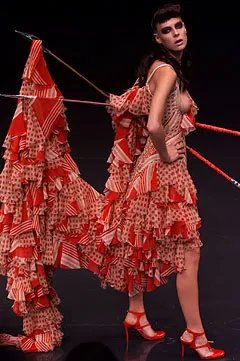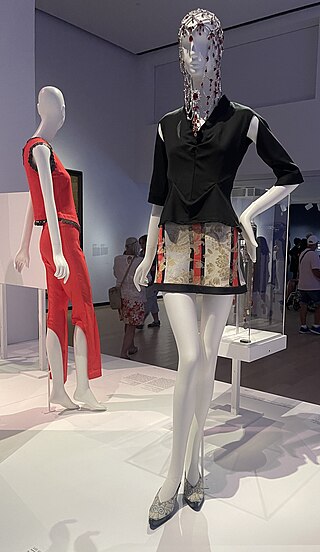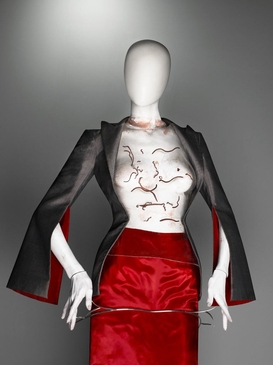
Philip Anthony Treacy is an Irish haute couture milliner, or hat designer, who has been mostly based in London for his career, and who was described by Vogue magazine as "perhaps the greatest living milliner". In 2000, Treacy became the first milliner in eighty years to be invited to exhibit at the Paris haute couture fashion shows. He has won British Accessory Designer of the Year at the British Fashion Awards five times, and has received public honours in both Britain and Ireland. His designs have been displayed at the Victoria and Albert Museum and the Metropolitan Museum of Art.

Lee Alexander McQueen was a British fashion designer and couturier. He founded his own Alexander McQueen label in 1992, and was chief designer at Givenchy from 1996 to 2001. His achievements in fashion earned him four British Designer of the Year awards, as well as the Council of Fashion Designers of America International Designer of the Year award in 2003. McQueen died by suicide in 2010 at the age of 40, at his home in Mayfair, London, shortly after the death of his mother.

Christopher John Kane is a Scottish fashion designer based in London.

Daphne Diana Joan Susanna Guinness is an English fashion designer, socialite, actress, film producer, and musician.

Alexander McQueen is a British luxury fashion house founded by the designer Alexander McQueen in 1992. After his death, Sarah Burton was its creative director, from 2010 to 2023. Gianfilippo Testa has been CEO since March 2022 and Seán McGirr has been creative director since October 2023. The house specializes in haute couture, ready-to-wear, premium leather accessories, as well as footwear.

It's a Jungle Out There is the tenth collection of the British fashion designer Alexander McQueen, and the first one released after his debut as the creative director of the French haute couture house Givenchy. The collection was presented at the Borough Market in February 1997 and it featured a total of 75 looks inspired by Thomson's gazelle. Fur, silk, leather and acid-washed denim were used for the confection of the garments; additionally, some of the pieces featured antlers and taxidermy crocodile heads, human hair and iron jewellery. Acclaimed by the press, this collection restated McQueen as one of the leading figures in fashion after his highly criticized debut with Givenchy. In 2011, several pieces were displayed in the exhibition dedicated to the designer's career, Alexander McQueen: Savage Beauty, at the Metropolitan Museum of Art in New York and, in 2015, at the Victoria and Albert Museum in London.

The armadillo shoe is a high fashion platform shoe created by British fashion designer Alexander McQueen for his final collection, Plato's Atlantis. Only 24 pairs exist: 21 were made during the initial production in 2009, and three were made in 2015 for a charity auction. The shoes are named for their unusual convex curved shape, said to resemble an armadillo. Each pair is approximately 12 inches (30 cm) from top to sole, with a 9-inch (23 cm) stiletto heel; this extreme height caused some models to refuse to walk in the Plato's Atlantis show. American singer Lady Gaga famously wore the shoes in several public appearances, including the music video for her 2009 single "Bad Romance".

The Widows of Culloden is the twenty-eighth collection by British fashion designer Alexander McQueen, made for the Autumn/Winter 2006 season of his eponymous fashion house. It was inspired by his Scottish ancestry and is regarded as one of his most autobiographical collections. It is named for the women widowed by the Battle of Culloden (1746), often seen as a major conflict between Scotland and England. Widows makes extensive use of the McQueen family tartan and traditional gamekeeper's tweeds, as well as other elements taken from Highland dress. Historical elements reflected the fashion of the late Victorian era and the 1950s.

The illusion of Kate Moss is an art piece first shown at the conclusion of the Alexander McQueen runway show The Widows of Culloden. It consists of a short film of English model Kate Moss dancing slowly while wearing a long, billowing gown of white chiffon, projected life-size within a glass pyramid in the centre of the show's catwalk. Although sometimes referred to as a hologram, the illusion was made using a 19th-century theatre technique called Pepper's ghost.

The Dance of the Twisted Bull is the nineteenth collection by British designer Alexander McQueen for his eponymous fashion house. Twisted Bull was inspired by Spanish culture and art, especially the traditional clothing worn for flamenco dancing and bullfighting. In McQueen's typical fashion, the collection included sharp tailoring and historicist elements and emphasised femininity and sexuality.

The Birds is the fifth collection by British designer Alexander McQueen for his eponymous fashion house. The Birds was inspired by ornithology, the study of birds, and the 1963 Alfred Hitchcock film The Birds, after which it was named. Typically for McQueen in the early stages of his career, the collection centred on sharply tailored garments and emphasised female sexuality. McQueen had no financial backing, so the collection was created on a minimal budget.

Neptune is the twenty-seventh collection by British designer Alexander McQueen for his eponymous fashion house. It took inspiration from classical Greek clothing, 1980s fashion, and the work of artists influential in that decade. The runway show was staged during Paris Fashion Week on 7 October 2005 at the industrial warehouse of the Imprimerie Nationale. Two main phases were presented, with 56 looks total: the first phase comprised monochrome black clothing, while the second featured a white, green, and gold palette. The collection's clothing and runway show both lacked McQueen's signature theatricality, and critical reception at launch and in retrospect was negative. Items from Neptune appeared in the 2022 exhibition Lee Alexander McQueen: Mind, Mythos, Muse.

The oyster dress is a high fashion gown created by British fashion designer Alexander McQueen for his Spring/Summer 2003 collection Irere. McQueen's design is a one-shouldered dress in bias-cut beige silk chiffon with a boned upper body and a full-length skirt consisting of hundreds of individual circles of organza sewn in dense layers to the base fabric, resembling the outside of an oyster shell. According to McQueen, the gown took a month's work for three people, who cut and assembled all the pieces individually. In addition to the original beige dress, a version with a red bodice and the ruffled skirt in rainbow colours was also created. The beige and red versions appeared in the Irere runway show, and were photographed for magazines to promote the collection.

Eye was the fifteenth collection by British fashion designer Alexander McQueen for his eponymous fashion house. It was inspired by the culture of the Middle East, particularly Islamic clothing, as well as the oppression of women in Islamic culture and their resistance to it. The collection crossed traditional Middle Eastern garments with elements drawn from Western fashion such as sportswear and fetishwear. Jeweller and frequent McQueen collaborator Shaun Leane provided the collection's best-known design: a yashmak made from chainmail.

The Hunger is the seventh collection by British designer Alexander McQueen for his eponymous fashion house. The collection was primarily inspired by The Hunger, a 1983 erotic horror film about vampires. McQueen had limited financial backing, so the collection was created on a minimal budget. Typically for McQueen in the early stages of his career, the collection centred around sharply tailored garments and emphasised female sexuality. It was his first collection to include menswear.

The Overlook was the fourteenth collection by British fashion designer Alexander McQueen for his eponymous fashion house. It was inspired by the Stanley Kubrick horror film The Shining (1980) and named for the fictional Overlook Hotel where much of the film takes place. The collection focused on winter clothing in light and neutral colours, including chunky knitwear, fur and shearling coats, and parkas inspired by Inuit clothing. Showpiece items included a bustier made from rock crystal and a corset made from coils of aluminium, the latter provided by jeweller and frequent McQueen collaborator Shaun Leane.

Pantheon ad Lucem is the twenty-fourth collection by British designer Alexander McQueen for his eponymous fashion house. Inspired by ideas of rebirth, ancient Greek garments and science fiction films including 2001: A Space Odyssey (1968) and Star Wars (1977), the collection focused on sleek draped, wrapped, or tied jersey designs in light and neutral colours, with some evening wear in darker colours. Contrasting the slimline items were heavier garments including tweed suits and fur coats. McQueen expressed his fascination with altering the silhouette, emphasising the hips to a degree that was uncommon for him.

Joan was the twelfth collection by British fashion designer Alexander McQueen for his eponymous fashion house. Continuing McQueen's dual fascination with religion and violence, it was inspired by imagery of persecution, most significantly the 1431 martyrdom of French Catholic saint Joan of Arc, who was burned at the stake. The collection's palette was mainly red, black, and silver; colours which evoked notions of warfare, death, blood, and flames. Many looks referenced ecclesiastical garments and medieval armour, including several items that mimicked chainmail and one ensemble that had actual silver-plated armour pieces.

The Horn of Plenty: Everything But the Kitchen Sink is the thirty-fourth collection by British fashion designer Alexander McQueen, made for the Autumn/Winter 2009 season of his eponymous fashion house. The collection drew on household rubbish and the aesthetics of classic haute couture fashion to satirise the fashion industry for its wastefulness and lack of originality. The Horn of Plenty also featured reimagined designs and reworked items from previous collections, serving as a retrospective of McQueen's own design history. Common design flourishes included houndstooth patterns, design elements overdone to ironic proportions, and prints based on the natural world. Production was shadowed by photographer Nick Waplington, who published a photo book documenting the collection's creation in 2013.





















